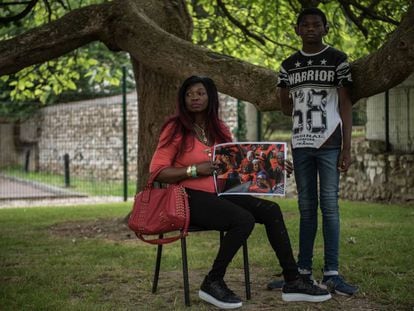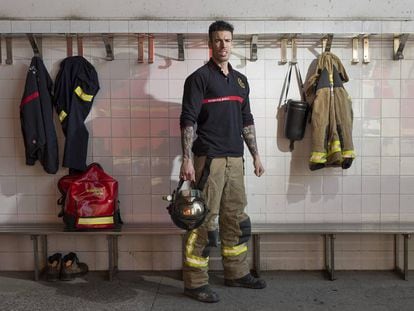How the streets of Barcelona have become a refuge for unaccompanied migrants
Rising numbers of minors and young adults who are homeless and in some cases are committing crimes have left the local authorities overwhelmed

In a tucked-away corner of the Sant Pau del Camp gardens, in the heart of Barcelona’s El Raval neighborhood, a group of young immigrants are sitting on the grass chatting. One of them is sniffing glue from a bag. For some time now, this park has been their home. Located not far from a regional police station and a Civil Guard barracks, they are living there with another hundred or so people. Other youngsters like them, who have ended up in Catalonia from North Africa and with no family members to take care of them, also sleep on the banks of the Montjuïc hill, a few meters from the Magic Fountain, a major tourist attraction in the Catalan capital. These youngsters are also to be found in Collserola Park.
Since 2015, a total of 7,248 unaccompanied adolescents have arrived in Catalonia – 1,129 this year until June
According to the regional government, the Generalitat, the young migrants who sleep in the streets are few in number. The majority of them are within the protection system of the social services. But the presence of youngsters who are sleeping on the streets of the city has put the Catalan government on alert, and activated an action plan to strengthen the numbers of social workers in the streets. The relevant agencies admit that they are overwhelmed by the problem.
Since 2015, a total of 7,248 unaccompanied adolescents have arrived in Catalonia – 1,129 this year until June. Of these, 4,203 youngsters (501 in Barcelona) are under the Generalitat’s protection. The rest are no longer under the care of the authorities, or have managed to evade the system. That is the case of the youngsters in El Raval.
“They survive by selling drugs, stealing cellphones or even prostituting themselves,” explains Peio Sánchez, the parish priest at Santa Anna church, in the central district of Ciutat Vella, which helps the homeless. Sánchez says that some of the youngsters arrive at the church with severe mental problems and substance addictions, including glue. The presence of some of these young men resting on the pews of the church raised the alarm to the issue this last week.
Within its action plan, the Generalitat has sent out a team that will analyze the more complex cases one by one. According to social services, the majority of the young immigrants who arrive in Catalonia enter – and stay within – the protection system. But, they say, there is “a small percentage” – they have not confirmed how many – “who are resistant to the system.” When they are taken into a shelter, they escape. Many of these, the authorities add, come from street environments in their countries of origin.
The risk of falling into a dynamic of street living depends on factors such as the lives that they had back in their countries of origin
Montse Soria, Pere Tarrés Foundation
“It’s a very varied collective,” explains Montse Soria, the coordinator of Social Activities at the NGO Pere Tarrés Foundation. “The risk of falling into a dynamic of street living depends on factors such as the lives that they had back in their countries of origin, and the migratory route they took.” Working on their lack of family ties is also complicated. “They have expectations when they migrate and, when they get here, it’s not what they expected,” Soria explains. “That generates frustration and anger that needs to be managed.”
Since June 2017, the regional government has created 3,000 places for such cases at 250 centers. But the experts say they need more resources. “With such diverse needs, you need time to be able to deal with them all,” Soria explains. “The problem is that the time frames are not set by the youngster or by the educator, but rather the bureaucracy.” The social educators have to regularize the situation of the migrants as quickly as possible, helping them to learn the language and get some kind of training before they turn 18. If they are not minors when they arrive, they are not included within the protection system and the risk of ending up on the streets is even greater.
Near La Rambla in Barcelona, there is a building that has been taken over by migrants who are demanding their rights. Five youngsters who were previously under the care of the regional government have arrived there this month. In administrative terms, they are now adults, and they have come to the building in search of a place to sleep. “Since I left the system, I’ve been forced to live in squats,” explains Mahdt Khou, 22, and originally from Morocco. “I don’t want any problems.” When he was 13, Khou managed to hide under a truck trailer in Tangiers and got on a boat to Barcelona. He was in a number of regional government centers and got some high school studies. Khou says that the youngsters arriving now have more problems. “They’re taking drugs, there is no future for them,” he laments.
The arrival of the migrants could partly explain part of the uptick in crime that has been seen over the last year or so
The priest at Santa Anna agrees that the young men living in the street are very aggressive. According to the local residents of El Raval, they are also victims of the criminal gangs who operate in the neighborhood, being used as a “workforce” to rob tourists or deal drugs.
The regional police force, the Mossos d’Esquadra, know that the young migrants are not responsible for the majority of the crimes that are committed in Barcelona. But their arrival could partly explain part of the uptick in crime that has been seen over the last year or so, which has coincided with the arrival of more youngsters (2018 saw an increase in crime of 17% in the city). Analysis by the Catalan police suggests that 18% of the migrants who arrived since 2016 have committed some kind of crime. These figures include minors and also young adults who are outside the system.
Of these, 12% have taken part in more serious offenses, such as violent thefts and robberies, while the remaining 6% have been involved in lesser crimes, such as vandalism or thefts of amounts under €400. The Mossos have created a specific operational plan to deal with the situation, and have put in place a unit of plainclothes officers. The problem, police sources explain, is with the youngsters who have turned 18. “They are aged between 18 and 22,” the sources say. “They work in groups. No one has shown them how to steal and they use violence.”
The issue is compounded by the fact that this group acts as a reference point for the minors who arrive, as well as representing a network that they can join. “They use [the young people],” the same sources say. They are the lower levels of the groups that steal cellphones and luxury watches in the city.
The social criminalization of these youngsters and the reports against them for thefts and even attempted rapes has affected the social harmony in some municipalities where there are children’s shelters. Within this context, sources from the Generalitat say, far-right groups are taking advantage in order to encourage violent acts against them, such as a recent attempt to attack one such center in El Masnou, an incident that saw four youngsters left with injuries.
English version by Simon Hunter.












































